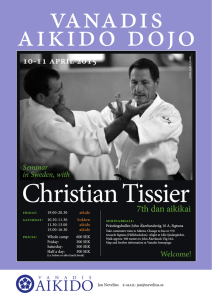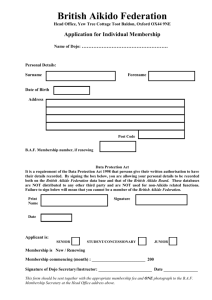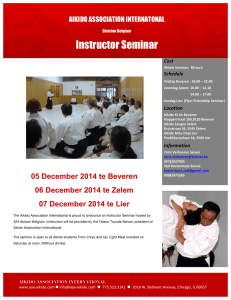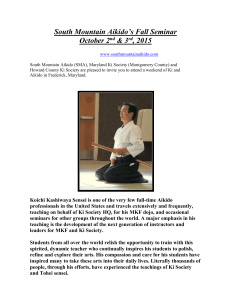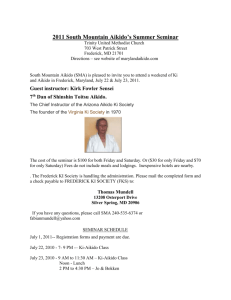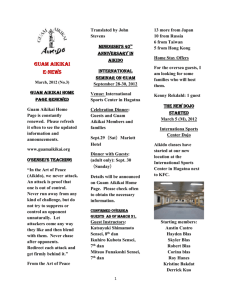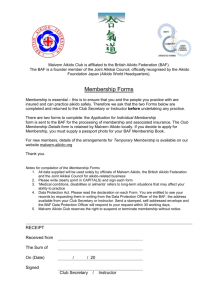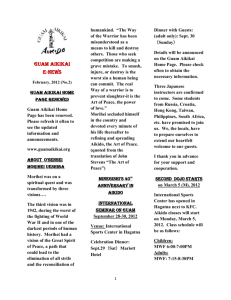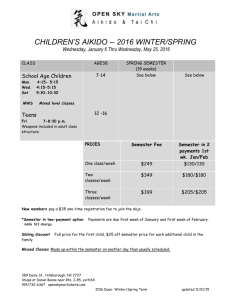PDF (for reading & printing)
advertisement
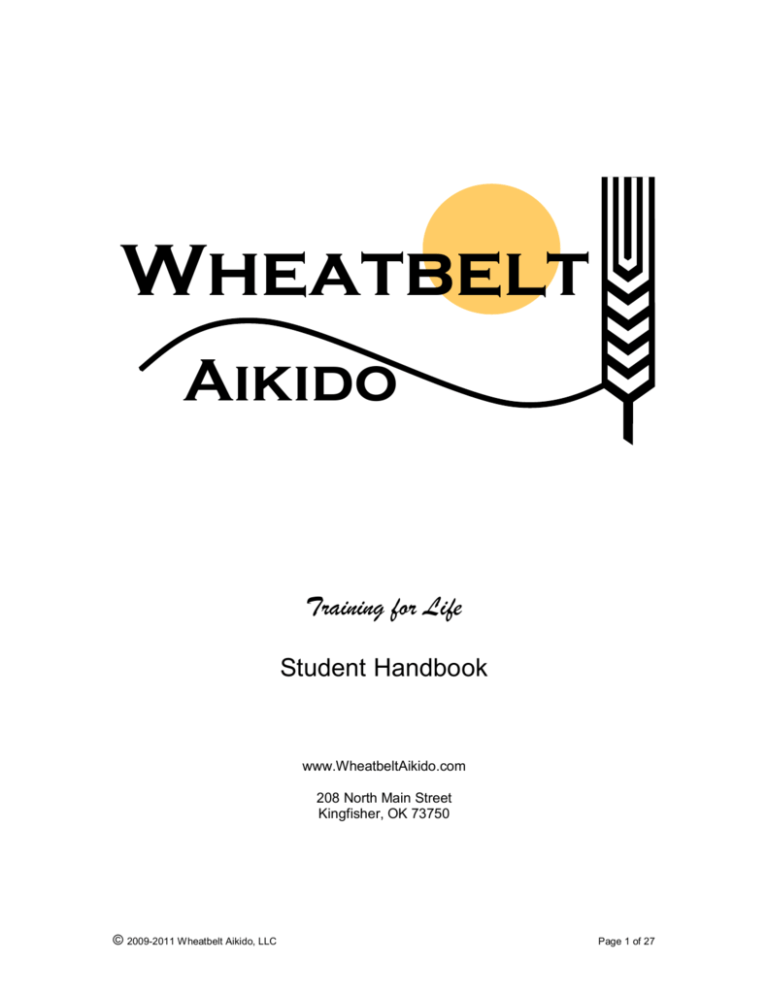
Wheatbelt Aikido Training for Life Student Handbook www.WheatbeltAikido.com 208 North Main Street Kingfisher, OK 73750 © 2009-2011 Wheatbelt Aikido, LLC Page 1 of 27 Wheatbelt Aikido: Student Handbook Letter to Dojo Members ............................................................................................... 3 Training Principles from the Founder ........................................................................... 4 Conduct Outside of Class ............................................................................................ 6 Preparations Prior to Coming to the Dojo ..................................................................... 7 At the Dojo, Before Class............................................................................................. 8 At the Dojo, During Class............................................................................................. 9 After Class ................................................................................................................. 11 Teaching and Learning .............................................................................................. 12 Cooperation and Consideration ................................................................................. 14 Ranks and Testing ..................................................................................................... 16 Kyu Ranks.............................................................................................................. 16 Dan Ranks ............................................................................................................. 17 Teaching Ranks ..................................................................................................... 17 Styles of Aikido....................................................................................................... 18 Birankai North America Mission & Vision ................................................................... 20 This is who we are: ................................................................................................ 20 This is where we are going: .................................................................................... 20 Birankai North America Teachers Statement of Professional Ethics .......................... 21 Aikido Vocabulary / Japanese Terminology ............................................................... 22 © 2009-2011 Wheatbelt Aikido, LLC Page 2 of 27 Wheatbelt Aikido: Student Handbook Letter to Dojo Members Dear Wheatbelt Aikido Member, Welcome to Wheatbelt Aikido. I hope that this handbook will help you better understand the training process as we help each other to deepen our mastery of Aikido. Membership in an Aikido dojo is not like membership in a health club or a gymnasium. Your Wheatbelt Aikido membership here makes you part of both a global community and a local family of people training together to improve themselves. The process of Aikido training is a journey that fundamentally and profoundly changes us. In our training sessions, our partners threaten us by attacking and we learn to respond by: Relaxing our bodies Focusing our minds Calming our spirits Making martially appropriate responses To do this we must face up to our own fears, ignorance, and physical limitations. Through sincere training, we learn to control our attacker by controlling ourselves. What we practice during our formal classes caries over into our daily lives. We can observe our progress during our everyday activities in the form of more relaxed and spontaneous actions and a heightened sense of awareness. By practicing Aikido diligently over a period of time, we enjoy the benefits of: True self-defense Improved general health Renewed intensity in our own personal search for truth Greater sensitivity in our dealings with others Certainly, such results do not come easy. However, they do proceed naturally from sincere and dedicated training. By learning to accomplish things that are difficult in class, you will also acquire more confidence when trying to accomplish difficult things in other areas of your life. We hope your training is enjoyable and productive. This handbook will help you become acquainted with some of the basic expectations that are common to Aikidoka (i.e. Aikido students) around the world. Sincerely, Neal Dunnigan, Chief Instructor Wheatbelt Aikido © 2009-2011 Wheatbelt Aikido, LLC Page 3 of 27 Wheatbelt Aikido: Student Handbook Training Principles from the Founder Reminders in Aikido Practice by Morihei Ueshiba (1883-1969), Founder of Aikido A.K.A O-Sensei (i.e. Great Teacher) 1. Aikido decides life and death in a single strike, so students must carefully follow the instructor's teaching and not compete to see who is the strongest. 2. Aikido is the way that teaches how one can deal with several enemies. Students must train themselves to be alert not just to the front but to all sides and the back. 3. Training should always be conducted in a pleasant and joyful atmosphere. 4. The instructor teaches only one small aspect of the art. Its versatile applications must be discovered by each student through incessant practice and training. 5. In daily practice first begin by moving your body and then progress to more intensive practice. Never force anything unnaturally or unreasonably. If this rule is followed, then even elderly people will not hurt themselves and they can train in a pleasant and joyful atmosphere. 6. The purpose of Aikido is to train mind and body and to produce sincere, earnest human beings. Since all the techniques are to be transmitted personto-person, do not randomly reveal them to others, for this might lead to their being used by hoodlums. © 2009-2011 Wheatbelt Aikido, LLC Page 4 of 27 Wheatbelt Aikido: Student Handbook These six rules that O-Sensei defined are just as appropriate today as they were when in his lifetime. However, there are some important differences between today’s Aikido students vs. the Aikido students of O-Sensei’s time. When O-Sensei was teaching, a new student would have: Already had the equivalent of a black belt in at lease one other martial art. Prior knowledge of martial arts basics was automatically assumed. Previously obtained five letters of recommendation from distinguished guarantors who would personally vouch for the student. Any failure of the student would be a major disgrace to those sponsors. The students would all be from the same cultural background and share a common understanding of what was considered appropriate conduct while training. Today Aikido training is much more easily accessible to students all over the world and available to all with a desire to learn. However, matters of etiquette and tradition, which were assumed to be implicitly understood by Aikidoka in O-Sensei’s day, now need to be spelled out in detail in the dojo (i.e. training hall, in Japanese “way place” as in way-oflife or life journey) rules. While some of these dojo rules may individually appear superficial. However, when taken together they help us to create a harmonious atmosphere for safe and productive training. Specifically the purpose of these dojo rules is to: Teach attention to detail and build awareness Make training safer Set a proper mood and help focus the student’s concentration Be a visible sign of respect to the founder, the teacher, and the other students Provide Aikidoka from all over the world a common vocabulary of behavior that allows them to practice together Aikido was developed in Japan. Much of the terminology, methodology, and etiquette that are used by Aikidoka today are derived from this Japanese origin. This should not surprise us. For example, classical musicians around the world all use Italian terminology for musical notation. Another example is European fencing which universally uses French terminology. While the need to develop a small Japanese vocabulary may initially present a learning challenge to some new Aikidoka, it will later facilitate more advanced practice. As a side benefit, the new Aikidoka will gain some insights into a different culture. Aikido has no religious affiliation and students of all beliefs practice Aikido. One of the purposes of Aikido practice is to bring Aikidoka into a higher state of personal insight. This will manifest itself differently in each Aikidoka according to his or her own belief system. Irrespective of any religious beliefs, all students are expected to maintain a respectful attitude while at practice or in the dojo. By keeping this proper attitude, your Aikido practice can be serious, yet fun, and intense, yet relaxed; all at the same time! © 2009-2011 Wheatbelt Aikido, LLC Page 5 of 27 Wheatbelt Aikido: Student Handbook Conduct Outside of Class By virtue of their training, Aikido students have responsibilities to themselves, their community, and other Aikidoka (past and present). Remember that the “do” in Aikido indicates a way of life and is not restrictive to your time spent in class. 1. Beginning students are not to engage in unsupervised practice outside of class. 2. No student may engage in brawls, contests, or challenges. 3. Students must have the instructor’s permission before participating in any public or private Aikido demonstrations 4. Avoid discussions about the pros and cons of various martial arts styles. 5. Visiting other Aikido dojos is encouraged. Keep your sensei informed of your visits. Invite them to reciprocate and visit us. 6. Cross training in other martial arts is allowed, provided that you have your sensei’s prior permission. 7. It is respectful and polite to address the instructor as “Sensei” both on and off the mat. “Sensei” followed by the teacher’s first name is the more familiar form (e.g. Sensei Neal). The teacher’s last name followed by “Sensei” is the more formal expression (e.g. Dunnigan Sensei). © 2009-2011 Wheatbelt Aikido, LLC Page 6 of 27 Wheatbelt Aikido: Student Handbook Preparations Prior to Coming to the Dojo Students should come for class on time and ready to participate. Here are some things to keep in mind before you arrive: 1. Make certain that your appearance does not make you a hazard to yourself or others. a. Always keep your finger and toenails clean and short. Long nails can be very sharp and may cause injury to other students. Long nails are more likely to be bent back or split causing you injury as well. b. Do not wear rings, earrings, body rings, studs, watches, necklaces, or any other jewelry, including hair decorations on the mat. These items can cause injury to both you and your training partner. Any personal jewelry that can not be removed must be taped down. c. Long hair must be tied back otherwise it will be inadvertently grabbed or stepped on. d. If used, cologne or perfume should not be detectable. This is a consideration for students with asthma or allergies as well as a consideration for those whose taste in this different from yours. e. Never participate in a class if you have been consuming alcohol or any drugs that might impair your or otherwise alter your judgment, coordination, or pain threshold. f. If you are not able to participate in a class (e.g. recovering from an injury or illness), it is still beneficial for you to come and observe the practice. 2. Make certain that your training uniform (called a gi or dogi) is clean for practice. a. Gis may be judo or karate style, but in either case they must be white and not have any advertisements or decorations on them. Students may wear an official Wheatbelt Martial Arts patch on the shoulder area of the sleeve. Students may mark their lapel with their first name. b. A plain white t-shirt may be worn under the gi top. This is the norm for female members and it is acceptable for men as well. c. New students who do not have a gi then a track suit, sweat suit or loosely fitting garment will suffice. Because of the kinds of throws and falls done in Aikido, long sleeves and long pants are required. New students should have a gi by the start of their second month of training. 3. Make certain that your body is clean and ready for training. Give special attention to your hands, face, and feet. 4. If you have your own personal training weapons (e.g. staff – jo or wooden sword – bokken), see that they are ready for use. a. Keep your jo and bokken enclosed in a bag when transporting them to and from class. b. Do not use weapons which have splinters, chips or cracks of any size. © 2009-2011 Wheatbelt Aikido, LLC Page 7 of 27 Wheatbelt Aikido: Student Handbook At the Dojo, Before Class Entering the dojo provides the students an opportunity to clear their mind of the day-today world before starting practice. Aikidoka should always be aware of their spatial orientation when in the dojo. They must always know where they are positioned with respect to other students, the teacher, and the shomen (the front of the dojo, Japanese for “the top of the head/face”). 1. Getting yourself ready a. Aikidoka must perform a short bow in the direction of the shomen when entering the dojo. b. If you need to use the rest room or to wash up, this is the time to do it. (why would you want to interrupt your training in the middle of class?) c. Remove your shoes and place them neatly, in a straight line, at the shoe rack. It is a good idea to keep a pair of removable footwear (e.g. shower sandals, clogs, etc.) at the dojo. d. Ensure your name has been marked off in the attendance sheet. e. If you have any new injury or condition that limits your practice, always remind the instructor prior to the beginning of class. You can indicate an injured area by placing red tape over that portion of your gi. This will let other students know to be gentle. 2. See that the dojo is ready for practice a. Take care of any dojo business (e.g. dues) prior to the beginning of class b. If you see any visitors or new students: greet them, introduce yourself, and make them feel welcome. Visitors are always welcome to sit and observe in the designated viewing area. Visitors must not interact with the students or cause a distraction during practice. c. If you see anything in the dojo out of place, straighten it out, clean it up, or fix it. 3. Getting on the mat a. Before entering onto the mat, acknowledge your arrival with a kneeling or standing bow towards the front of the dojo. b. Do not be bashful about asking another student to review any techniques with which you might be needing extra work. c. You may warm up before class, but also try to sit in quiet meditation for a few minutes just before class begins. d. Do not touch or use the personal weapons of other Aikidoka without their permission. e. Get yourself in the zone. Aikido techniques require the student to be able to control his/her mind. Start here; put aside all thoughts of the events since the last class. © 2009-2011 Wheatbelt Aikido, LLC Page 8 of 27 Wheatbelt Aikido: Student Handbook At the Dojo, During Class 1. When the instructor bows toward the direction of the shomen, you do the same. 2. When the instructor bows to the class, return the bow to the instructor while saying onegai shimasu (oh-nigh-guy-she-mahss, Japanese for “please let us begin”) as an indication of your readiness to begin practice. 3. After the warm-up exercises and after the demonstration of a technique, bow first to the instructor and then to your partner before beginning your practice. Again use the term onegai shimasu when you bow to your partner as your way of inviting your partner to practice and letting them know that you are ready. 4. Try not to be late for class. If you are late, get dressed, then kneel by the side of the mat and wait until the instructor invites you to join the class. Thank the instructor with a bow and join the class. If you have missed the warm ups, take time to stretch out at the back of the mat. Then approach any group of students and ask to join them. 5. Practice can be intensive and yet still be friendly and pleasurable. Speak only when you have something to say related to the technique being practiced. Rather than verbalizing, start learning to communicate corrections to your partner through your attack and ukemi when you can. 6. Class is not the time to explore your own personal interpretations of the technique or theories on the martial arts. Save that for later. Practice the techniques in the style which the instructor is showing them. 7. When the instructor determines that it is time to stop or change techniques, the instructor will clap his hands or announce it verbally. At that time, bow to your partner, move quickly and quietly to the edge of the mat, and observe the demonstration from seiza (a kneeling position where you sit on your heels). 8. If the instructor stops your individual practice to provide clarification concerning a technique, move to a nearby place that is safely out of the way and observe while sitting in seiza. Avoid sitting with your back to the shomen. After the correction, bow to the instructor, then to your partner, and resume practice. 9. Should you need to adjust your gi during class, first bow to your partner to indicate the interruption in your practice. Then face away from both your partner and the shomen while straightening your gi. When you are done face your partner and indicate your readiness with a bow and the phrase “onegai shimasu”. 10. Once class has started, do not leave or reenter the mat area without first asking the instructor. 11. Injuries During Practice a. Always stop to report any injury to the instructor at the time that it occurs. b. Follow this protocol if you observe blood having been spilled. Stop your practice. Try to identify the source. Notify the instructor. Stop the bleeding on the injured person. Clean the spill with disinfectant cleaner. Resume practice. Note: always use latex gloves when working with blood. 12. There is no shame in having to stop to catch your breath. Sit in seiza or crosslegged at the edge of the mat. Correct posture is even more important when you are tired and out of breath. (Never lean on walls or columns in the dojo.) Your partner can join another pair until you are ready to continue. 13. At the end of class, straighten your gi and line up in an orderly row as in the beginning of class. Join the instructor in the bow towards the shomen. The © 2009-2011 Wheatbelt Aikido, LLC Page 9 of 27 Wheatbelt Aikido: Student Handbook instructor will then turn and bow to the students. The students will then return the bow while saying, “Domo arigato gozaimashita” thanking the teacher for the training. 14. After the teacher leaves the mat, individually bow to each of your practice partners and thank them for sharing the training. © 2009-2011 Wheatbelt Aikido, LLC Page 10 of 27 Wheatbelt Aikido: Student Handbook After Class 1. If there were any visitors, thank them for coming and try to answer any questions that they might have. 2. If there are any new students, check on their progress and see how their workout went. 3. In Aikido training, dojo cleaning is a way of showing thanksgiving. Dojo cleaning is also a representation of the need to cleanse our own minds and hearts. It is each student's responsibility to assist in cleaning the dojo at every workout. Student should undertake a sweep of the mat and a general pickup of the dojo after each class. From time to time, the students will be asked to participate in special dojo cleanings. 4. Do not be bashful about asking another student to review any techniques with which you might need extra work. 5. The dojo is not to be used for any purpose other than regularly scheduled classes without the direct permission of the head instructor. © 2009-2011 Wheatbelt Aikido, LLC Page 11 of 27 Wheatbelt Aikido: Student Handbook Teaching and Learning A senior Japanese Aikido instructor once made a comment to me that American students had a tendency to be too “cerebral” in their approach to Aikido. In our everyday conversations, we will often hear intellectual terminology used in reference to martial arts. For example: She knows Karate. He goes to an Aikido school. I am learning Aikido. They study Judo. While, there is nothing inherently wrong with any of those statements, they do illustrate a common American inclination to view the learning of martial arts as if it were an academic effort. Martial arts are experiential processes rather than intellectual accomplishments. As a result, it is more appropriate to speak of them in terms of: She went to Karate practice. I train in Aikido. Aikido techniques cannot be understood through explanations; they must be experienced and explored. Often students have a tendency to over rely on the instructor’s verbal explanation of a technique. Aikido techniques involve the coordinated movement of dozens (even hundreds) of muscles and vary each time they are performed. Verbal instruction is only a guideline. At best, the teacher can only describe the skeleton of the technique with words. It is in practice where the student puts flesh on the techniques and the teacher guides the student to refine the technique. Your progress is 99% related to your sincere repetition of the techniques. By way of illustration: in Japan, the nickname for Kokyu-Nage is the “20-year technique”. Ceaseless repetition is the way that Aikido training is practiced. Come to class mentally prepared for it. Do not waste time in class contemplating technique; you can spend that think time more productively outside of class. The martial art training is a process for transforming ourselves into more capable individuals. In this process, the teacher will often create situations where the student can discover the nature of the art for themselves. This places a higher responsibility on both the teacher and the student. These old martial arts sayings give an indication of how this works from the students’ perspective: When the teacher shows a corner, the student sees the square. The student is like the thread; the teacher is like the needle. The student must steal technique from the teacher. © 2009-2011 Wheatbelt Aikido, LLC Page 12 of 27 Wheatbelt Aikido: Student Handbook As the students gain more experience, they better understand the context of the technique. As a result, their practice becomes more natural and effective over time. It is common for both beginners and advanced students to be training with each other in the same class and all practicing basic techniques. However, their level of practice is different. The founder of Aikido used to speak of students progressing as if moving from stone to wood to water to air. In the beginning, students work on gross motor movements and basic footwork. Then gradually the students try to become more relaxed and flexible in their technique. Next, they learn to make their technique more adaptive to their partner’s unique attack. Finally, their focus shifts to making their techniques spontaneous. As students get more advanced, their ability to learn expands. When beginning students watch the teacher demonstrate a technique, typically they only see the attack and the throw. The students then try to imitate what they believe that they have seen. What the beginners’ perception misses are the more subtle variables: distance, timing, relationship, balance, momentum, focus; all of the things that make the technique work properly. When all of those things are in place, the throw is incidental! This phenomenon is reflected in this poem: Iceberg technique! Not being of the ocean, plain sight is the water which conceals the hidden 7/8 th. Generally, it is the responsibility of the sempai (i.e. senior student) rather than the sensei (i.e. instructor, in Japanese “born before”) to inform the kohai (i.e. junior student) about dojo etiquette, housekeeping, and technique basics. In Aikido tradition, as with other traditional Japanese martial arts, it is the sensei’s role to teach, it is the senior students’ role to prepare the junior students to learn. © 2009-2011 Wheatbelt Aikido, LLC Page 13 of 27 Wheatbelt Aikido: Student Handbook Cooperation and Consideration Always practice the exact technique demonstrated by the instructor. While on the mat, limit your verbal corrections to your partner. We learn best through experience, not words. Use your ukemi (i.e. taking the fall) to help correct your partner's movement; leave the verbal explanations to the instructor. Be kind and sensitive to the age, experience and abilities of your partner. Cause no harm to your partner. If your partner is at a lower level, tone down the speed and intensity of your technique to your partner’s level. This does not mean that you lower your level of concentration or precision. Maintain a constant speed throughout your technique. Do not begin the technique slowly and then suddenly speed up at the end. Do slow down a technique if you realize that you are practicing faster than what is reasonable for you and your partner. Counter strikes (atemi) are an important part of you Aikido practice. The counter strike serves several purposes in Aikido. They are used to: Steal the attacker’s concentration Limit the attacker’s options for movement Test that the attacker and defender have the proper spatial relationship in terms of distance and alignment It is never acceptable in practice to try to compensate for a deficient technique by increasing the emphasis on atemi. Follow the model set by the teacher to see how much and what type of atemi is to be practiced at that particular class. Ukemi is an art of staying safe, even after your partner has gained the advantage and is going to throw or pin you. Almost half of your Aikido practice will be spent taking ukemi. You will want to make the most of this investment of your time and effort. If you hate to be thrown, you cannot expect to become a master of the art. By taking throws time after time, you learn to take falls and overcome the fear of being thrown. Then you will become unafraid of being attacked and be able to take the initiative in an attack. Ukemi is active, not passive. It is true that when taking a fall you must relax and remain flexible. However, you must not act like a rag doll. You must control your breathing and expend energy to stay in a safe position. You will want to maintain balance until the tipping point where your body becomes unstable and you fall or roll. From this perspective, ukemi can be viewed as a controlled process for giving your body to the nage. Likewise, ukemi should not be faked. You should not start to fall before you get to the tipping point. Neither should you propel yourself into a spectacular fall by adding more energy than is required by the thrown. Both partners should stay connected, not disjointed, during the entire throw. At the end of the ukemi, both partners should maintain a moment of zanshin (focused concentration) before moving on to the next technique. If you practice with these points in mind, you will eventually: Be able to advance from simple ukemi to more advanced ukemi Be able to blend with the throw and counter it with a reversal (Kaishi-waza) Be able to better survive accidental falls outside of class Be a more desirable training partner for other Aikidoka © 2009-2011 Wheatbelt Aikido, LLC Page 14 of 27 Wheatbelt Aikido: Student Handbook When you are in the role of uke, you must have a sincere, committed attack. By this we mean: Your attack is martially appropriate in that you attack from a position of relative safety, without creating an opening for a counter strike Your attack is focused on the target and has follow through You complete your attack from a position of extension and balance These traits are not to be confused with a berserk or banzai attack. Depending on the skill level and physical characteristics of your partner, you will vary the speed and force of your attack. However, even at low speed and light intensity, your attack should demonstrate the attributes described above. Whether you are in the role of uke or nage, your contact with your partner must always be relaxed yet firm. If your contact is stiff or ridged, your body will not be able to sense your partner’s balance or motion. Use your physical contact to establish a communication bridge to read your partner’s intent. Always maintain your spatial awareness. Always know where the front and back sides of the dojo are. Always know where the people around you are, where they are moving, and how fast. There is no reason for students to collide into each other. Always greet new students and visitor so that they know that you are glad to meet them. As an Aikidoka, you are an ambassador for Aikido in general and for Wheatbelt Aikido specifically. It is a good thing to have an opportunity to politely introduce someone to the benefits of Aikido practice. It is also a good thing to encourage your fellow student in their training; especially junior students. Sempai should always take an interest in kohai and mentor them in with respect to their training. Help your school focus on teaching rather than administration. Have you dues and any other fees paid on time. There are many aspects to Aikido training besides the time spent in class. Dojo cleanups, improvements to the dojo, parties, demonstrations, and special training seminars are all part of the process. The active participation of the membership helps make special events a fun extension to our normal training. © 2009-2011 Wheatbelt Aikido, LLC Page 15 of 27 Wheatbelt Aikido: Student Handbook Ranks and Testing As in other martial arts, Aikido helps students monitor their progress in the art by awarding ranking promotions as the student advances. Black belt levels are called “dan ranks”. The names of the dan levels start at the number one and progress higher as the student advances. The levels below black belt are called “kyu ranks”. The names of the kyu levels start with the number six and count down to the number one as the student advances to black belt. Wheatbelt Aikido follows the testing and promotion guidelines set up by the North American branch of the Birankai International Aikido organization. Students wishing to test must be current in their membership with Birankai. Birankai also establishes standards for teacher certification for the teaching ranks of Assistant Instructor (Fukushiodin), Instructor (Shiodin) and Master Instructor (Shihan). Kyu Ranks The Aikidoka who hold kyu ranks are called mudansha. Wheatbelt Aikido follows the typical Aikido convention of designating all kyu ranks as “white belts”. In Aikido, colored belts are sometimes used to designate kyu ranks in the children classes. At the kyu level, the examination system is intended to reflect the natural progress of a typical student. So if a student has trained the appropriate number of classes, he or she should be reasonably prepared to take their next test when the time comes. Naturally, a little extra effort toward examination time will help as well. General requirements for kyu level promotions include: Good standing in the dojo; including: dues, attitude, and participation Good standing in Birankai: including membership and testing fees A minimum number of training hours and elapsed time from the date of the last promotion The ability to demonstrate a clear understanding of basic techniques appropriate to the rank being tested for © 2009-2011 Wheatbelt Aikido, LLC Page 16 of 27 Wheatbelt Aikido: Student Handbook Dan Ranks Dan ranks are black belt ranks. The Aikidoka who hold dan ranks are called yudansha. The lower levels of black belt ranks typically require formal testing or examinations. This typically takes place at the annual Birankai regional or national seminars. These ranks are: Shodan (1st degree) Nidan (2nd degree) Sandan (3rd degree) The tests are similar in nature to the kyu tests, but are more comprehensive. In addition, the testing board looks for the students’ ability to adapt their movements to the force and timing of the attack. Concentration and awareness must be maintained by the student throughout the examination. Advancement to the higher levels of black belt ranks do not typically require formal testing or examinations. Instead, these ranks are awarded after years of observation by senior members of the Aikido community. These ranks include: Yondan (4th degree) Godan (5th degree) Rokudan (6th degree) Shichidan (7th degree) Hachidan (8th degree) Kudan (9th degree) Judan (10th degree) In addition to progressively more excellent technical skill, these advanced practitioners are expected to eventually embody the essence of Aikido and to exhibit it in their every day activities. Teaching Ranks Birankai also establishes standards for teacher certification for the teaching ranks. These teaching designations are in addition to the standard ranking system. They are: Associate Instructor (i.e. Fukushiodin) required minimum rank of 1st dan Instructor (i.e. Shiodin) required minimum rank of 4th dan Master Instructor (i.e. Shihan) required minimum rank of 6th dan Note: Birankai requires certified teachers and teacher candidates to augment their Aikido training with meditation (zazen) and Iaito practice. © 2009-2011 Wheatbelt Aikido, LLC Page 17 of 27 Wheatbelt Aikido: Student Handbook Styles of Aikido Some of Morihei Ueshiba’s leading students came away with various interpretations of Aikido and developed their own ideas on how they might improve on them. There were several factors that contributed to this: Morihei Ueshiba taught for many years and students from his earlier days may have developed a different perception of the art than did later students. Morihei Ueshiba’s teaching career spanned dramatic historical and cultural changes in Japanese society and the perspectives of his students varied over time. Unlike his contemporaries, Jigoro Kano (Judo) and Gichin Funakoshi (Karate), who were professional educators in addition to being martial art masters, Morihei Ueshiba was not very interested in developing a formal pedagogy for the instruction of his martial art. As a result, many of his students came up with their own divergent teaching systems. Traditional Styles The traditional Aikido styles are referred to as Aikikai styles. These schools retain close affiliations with the main Hombu Dojo in Tokyo through the International Aikido Association. The execution of techniques in these schools is similar, but these schools take different approaches to curriculum, rank promotions, and organization. In the United States, the following major traditional styles can be found: Aikido Schools of Ueshiba – founded by Mitsugi Saotome American Aikido Association – founded by Fumio Toyoda Birankai International – founded by Kazuo Chiba California Aikido Association – founded by several California teachers United States Aikido Federation – lead by Yoshimitsu Yamada Independent Styles The independent Aikido styles are independent from the main Hombu Dojo. These styles are more divergent in their interpretation of techniques than the traditional styles. Tomiki AIkido, or Shodokan Aikido was founded by Kenji Tomiki, and early student of O-sensei and also of Judo founder Jigoro Kano. Tomiki believed that a "rationalization" of Aikido training, along the lines that Kano Sensei followed for Judo would make it more easily taught, particularly at the Japanese Universities. In addition, he believed that introducing an element of kata competition would serve to sharpen and focus the practice since it was no longer tested in real combat. Yoshinkan Aikido was established in 1955 by Gozo Shioda, who studied with O-Sensei from 1932 to 1940. The techniques of Yoshinkan represent a harder style of Aikido, generally concerned with practical efficiency and physically robust movements. They strongly reflect the pre-war training by Shioda received from Morihei Ueshiba. The basic training curriculum is clearly defined and many techniques are practiced in kata-like fashion, particularly at beginner level. © 2009-2011 Wheatbelt Aikido, LLC Page 18 of 27 Wheatbelt Aikido: Student Handbook Shin-shin Toitsu Aikido (A.K.A Ki Society) – was founded in the 1970’s by Koichi Tohei, former hombu chief instructor under Morihei Ueshiba. One of the softest styles of Aikido that is characterized by fluid movements that often involve the practitioner jumping or skipping, something seldom seen in other styles. This style is not primarily concerned with physical application of the martial techniques, considering them exercises to further develop unification of mind and body. This style places a great deal of emphasis on understanding the concept of Ki and developing this aspect independently of the Aikido training for application to general health and daily life. Takemusu Aikido Association – follows the style of Aikido taught by Morihei Ueshiba when he retired to his farm in Iwama, Japan, during WWII. This association promotes the teaching and training methods as passed on by Morihiro Saito, who for many years ran the Aikido dojo and shrine in Iwama. © 2009-2011 Wheatbelt Aikido, LLC Page 19 of 27 Wheatbelt Aikido: Student Handbook Birankai North America Mission & Vision This is who we are: An association of Aikido Practitioners and dojos founded by T. K. Chiba Shihan, forged by rigorous training, tempered by mutual respect, and committed to the relentless pursuit of the art. This is where we are going: We desire to create a healthy, stable community which will preserve the technical and ethical principles transmitted to us by our founder, and develop clear guidelines through which the dynamic nature of his methodology and curriculum may be transmitted to future generations. This is where we are going: We desire to create a healthy, stable community which will preserve the technical and ethical principles transmitted to us by our founder, and develop clear guidelines through which the dynamic nature of his methodology and curriculum may be transmitted to future generations. © 2009-2011 Wheatbelt Aikido, LLC Page 20 of 27 Wheatbelt Aikido: Student Handbook Birankai North America Teachers Statement of Professional Ethics 1. Aikido Teachers, guided by a deep conviction of the worth and dignity of advancing the path of Aikido, recognize the special responsibilities placed on them as teachers and guides for their students. 2. Aikido teachers encourage and support the learning process of their students and demonstrate the best possible standards of the discipline and art of Aikido. They demonstrate respect for the student as an individual and adhere to their role as a guide and teacher. Aikido teachers avoid exploitation of their students for their personal advantage. They make every effort to assure that their evaluation of students reflects their true merit. Aikido teachers are aware of and sensitive to the power differential inherent in the teacher-student relationship. 3. As a member of Birankai North America, the Aikido teacher is committed to creating and maintaining a community free from all forms of disrespectful conduct including harassment and exploitation. 4. Aikido teachers and practitioners do not engage in sexual harassment. Sexual harassment is sexual solicitation, physical advances, or verbal or non-verbal conduct that is sexual in nature, that occurs in connection with the Aikido teacher’s activities or role as a teacher and that either: (1) is unwelcome, offensive, or creates a hostile environment, and the teacher knows or is told this; or (2) is sufficiently severe or intense to be abusive to a reasonable person in the context. Sexual Harassment can consist of a single intense or severe act or of multiple persistent or pervasive acts. Sexual harassment also includes requests of sexual favors, and other verbal or physical conduct of a sexual nature when such conduct has the purpose or effect of unreasonably interfering with an individual’s Aikido training or creating an abusive, hostile or offensive practice or learning environment. 5. Harassment is not limited to that of a sexual nature. Aikidoists do not knowingly engage in behavior that is harassing or demeaning to persons with whom they interact in the dojo environment based on factors such as the person’s age, gender, race, ethnicity, national origin, religion, sexual orientation, disability, language or socio-economic status. 6. The process to file a complaint for violation of this statement of ethics follows: a. Discuss the complaint with your Chief Instructor for guidance and recommendation. b. If the complaint involves the Chief Instructor, directly contact the Ethics Committee as in step c below. c. If the issue remains unresolved, a formal complaint must then be made in writing and sent to the Ethics Committee (see the Birankai web site for the current chairperson and contact information for the Ethics Committee). © 2009-2011 Wheatbelt Aikido, LLC Page 21 of 27 Wheatbelt Aikido: Student Handbook Aikido Vocabulary / Japanese Terminology Note: You are not expected to memorize this list! Over the course of your Aikido training, you will be exposed to most of these terms and this reference will help you to understand them. Numbers & Counting Go Five/Fifth Hachi/Hasso Eight/Eight Ichi/Sho One/First Ju/Jo Ten/Tenth Ku Nine/Ninth Ni Two/Second Roku Six/Sixth San Three/Third Shi/Yon Four/Fourth Shichi/Nana Seven/Seventh Expressions Domo Domo Arigato Domo Arigato Gozaimasu Dozo Giri Gomen nassai Hai Hajime Ie O negai shimasu Ous Rei Yame Thank you (informal) Thank you very much (more formal) Thank you very much for what you have done (most formal) Please Obligation, duty which must be honored I'm sorry, please forgive me for what I just did Yes Start No Please assist me In Aikido, one says this while bowing to the sensei at the beginning of class and to one’s partner before practicing a technique. Endeavor, persevere, overcome Salutation, bow Stop Common Words Aikidoka Ai Uchi Atemi Budo Budoka Dan Deshi Doshu Fudo A Student of Aikido Mutual Kill – when opponents simultaneously strike a killing blow A strike to the body The martial (warrior) way A martial artist Black Belt Rank A Disciple Head of the Art Immovable © 2009-2011 Wheatbelt Aikido, LLC Page 22 of 27 Wheatbelt Aikido: Student Handbook Gakusei Kata Kiai Kiri Keiko Kenshusei Kohai Kokyu Kyu Maai Mudansha Musubi Nage O Sensei Sempai Sensei Shihan Shomen Shugyo Seiza Suburi Suki Sutemi Tegakana Uchi Deshi Tatami Uke Ukemi Yadansha Zanshin A Student (not a disciple) Literally a “form” or “mold”. A prearranged practice. The purpose of a kata is to shape the practitioner who performs it. Literally "a meeting of the spirits," this is a penetrating cry or scream originating in the Hara. On the physical plane, kiai is manifest as a piercing shout emanating from the depths of one's being; on the spiritual plane, it is manifest as a steady outpouring of vital energy. Cut as in the path of a sword cut Practice / training / class Sword carrier / an Aikidoka training to be a teacher One's junior / lower ranked students Literally "breathing," or "breath," this refers to the Ki-power generated through the Hara, or one point in the lower abdomen. White Belt Rank The appropriate distance between an attacker and defender relative to their speed and body positions A Kyu Rank Holder (any rank below Shodan) Blending / the connection between Nage and Uke Thrower / The Aikidoka Practicing the Technique Great Teacher (Morihei Ueshiba, The Founder of Aikido) One's Senior, one with a high rank or more experience Teacher / One who Came/Born Before Master Instructor Head / top Training, Austerity (The Daily Struggle) Kneeling Repetitive strikes with a weapon to develop form Opening, Point of Weakness, blind spot To sacrifice the Body (the art of taking breakfalls) Handblade / knife hand Inner Disciple / house student / 24 hour attendant A practice mat. In Japan square straw mats were traditionally used as household flooring Receiver / The Attacker / Aikidoka being thrown The art of falling Black Belt Rank Holder Awareness of ones surroundings & situation / unbroken concentration / stillness at completion of a technique © 2009-2011 Wheatbelt Aikido, LLC Page 23 of 27 Wheatbelt Aikido: Student Handbook Attacks Kata Dori Katate Dori Ryote Mochi Katate Dori; Kosa Dori Kuchi Tsuki Mune Tsuki Randori Ryo Kata Dori Ryote Dori Shomen Uchi Ushiro RyoKata Dori Ushiro Ryote Dori Ushiro Tekubi Shime Yokomen Uchi Shoulder Grab One Hand Grabbing Both Hands One Hand Grab Cross Hand Grab Punch to the Mouth Punch to the Chest Chaos taking / free-style practice or sparring with multiple attackers Both Shoulder Grab Both Hands Grab Vertical Strike to the Head Rear Both Shoulder Grab Rear Both Hands Grab Rear One Hand Grab with Choke Oblique Strike to the Head Techniques (Waza) Aiki Otoshi Gokyo Hiji Jime Ikkyo Irrimi Nage Juji Waza Kaiten Nage Kokyu Nage Kokyu Tanden Ho Koshi Nage Kote Gaeshi Nikyo Sankyo Shiho Nage Sumi Otoshi Tenchi Nage Yonkyo Blending Drop 5th Principle (ude nobashi) Elbow Lock 1st Principle (udeosae) Entering Throw Cross Shaped Control Rotary Throw Breath Throw Centered Breath Method Hip Throw Wrist Twist 2nd Principle (kote mawashi) rd 3 Principle (kote hineri) Four Directional Throw Corner Drop Heaven and Earth Throw th 4 Principle (tekubi osae) © 2009-2011 Wheatbelt Aikido, LLC Page 24 of 27 Wheatbelt Aikido: Student Handbook Foot Movement (Ashi Sabaki) Ai Hanmi Ayumi Ashi Gyaku Hanmi Hamni Seiza Shikko Tenkai Tenkan Tsugi ashi Mutual Stance Alternating Step Opposite Stance / Mirror Image Open triangular stance Formal Seated Posture Knee Walking About Face Turn Full Turn Sliding Step Body Movement (Tai Sabaki) Chokusen no Irrimi En no Irrimi Hantai Irrimi Omote Sankaku no Irrimi Soto Tenkan Uchi Mawari Ura Direct Entering Circular Entering Opposite / reverse Entering Front, “public side” Triangular Entering Moving Outside One's Opponent Turning Moving Inside One's Opponent Rear, Behind, “private side” Types of Practice (Waza) Ara Waza Debana Waza Hanmi Handachi Henka Waza Jiyu Waza Kaeshi Waza Kihon Waza Nagare Waza Nage Nage Waza Ne Waza Oyo Waza Shime Waza Suwari Waza Uke Rigorous Versions Attacking at the Start / Forestalling / Ikkyo principle Nage Seated, Uke Standing Switching from One Technique to Another Free Style Reversing Techniques Basic Versions of Techniques Flowing Versions Thrower / The Aikidoka Practicing the Technique Throwing Techniques Ground Techniques Applied Versions Choking Techniques Seated Techniques Receiver / The Attacker / Aikidoka being thrown © 2009-2011 Wheatbelt Aikido, LLC Page 25 of 27 Wheatbelt Aikido: Student Handbook Weapons Bo Bokken Fukuro Shinai Iaito Jo Katana Ken / To Kwaiken Naginata Shin Ken Shinai Suburi To Tachi Tanto Wakizashi Yari Long Staff Wooden Sword Shinai covered in leather `bag' (Yagyu style) Practice Metal Sword (Not Sharp) Short Staff Long Sword Sword Knife Halberd Live Sword Bamboo Practice Sword Heavy Wooden Sword for suburi practice Long sword mounted blade down for use on horseback Knife Short sword / companion sword Spear Weapon Techniques Aiki Jo Aiki Ken Jo / Taijutsu no Riai Jo Dori Jo Ken no Riai Jo no Awase Ho Jo no Suburi Ken / Taijutsu no Riai Ken no Awase Ho Ken no Suburi Kumi Jo Kumi Tachi Tachi Dori Tanren Uchi Tanto Dori Short Staff Principles Based on Aikido Swordsmanship Based on Aikido Staff / Body Relationship Studies Jo Taking Staff / Sword Relationship Studies Joined Staff Training Repetitive Practice with Jo Sword / Body Relationship Studies Joined Sword Training Repetitive Practice with Sword Paired Jo Training Paired Sword Training Sword Taking Forging One's Center by Striking with Sword or Staff Knife Taking Sword Stances Chudan no Kamae Gedan Hasso no Kamae Gedan no Kamae Hitoemi Jodan no Kamae Kesa Giri Seigan © 2009-2011 Wheatbelt Aikido, LLC Middle Level Stance Low Eight Directional Stance (Waki Hanmi) Low Level Stance To Make One's Body Small High Level Stance A diagonal strike following the path of the lapel of a robe Extended Chudan no Kamae (lit. five in a row) Page 26 of 27 Wheatbelt Aikido: Student Handbook Jo Stances Gyakute no Kamae Honte no Kamae Sage Jo Tate no Jo Reversed Hand Stance Root Hand Stance (same as chudan with sword) Stand with Staff Under Arm Stand with the Staff Jo Techniques Tsuki no Bu Choku Tsuki Gaeshi Tsuki Ushiro Tsuki Choku Tsuki Gedan Gaeshi Choku Tsuki Jodan Gaeshi Uchi no Bu Shomen Uchi Komi Renzoku Uchi Komi Menuchi Gedan Gaeshi Menuchi Ushiro Tsuki Gyaku Yokomen Uchi Ushiro Tsuki Katate no Bu Katate Gedan Gaeshi Toma Katate Uchi Katate Hachi no Ji Gaeshi Hasso no Bu Hasso Gaeshi... Uchi Tsuki Ushiro Tsuki Ushiro Uchi Ushiro Harai Nagare no Bu Hidari Nagare Gaeshi Uchi Migi Nagare Gaeshi Tsuki © 2009-2011 Wheatbelt Aikido, LLC Thrusts Middle Thrust Twisting Thrust Rear Thrust Middle Thrust, Low Twist Middle Thrust, High Twist Strikes Vertical Strike to the Head Continuing Strikes to the Head Strike to the Head, Low Twist Strike to the Head, Rear Thrust Reverse Oblique Strike to the Head, Rear Thrust One Handed One Handed Low Twist Long Distance One Handed Strike One Handed Figure EightTwist Figure Eight Shapes Figure Eight Twist... Strike to the Head Thrust Rear Thrust Rear Strike Rear Sweep Flowing Movements Left Flowing Strike, Strike Right Flowing Strike, Thrust Page 27 of 27
